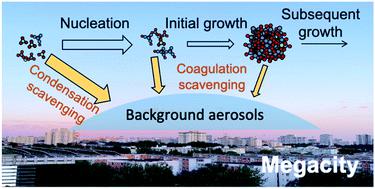当前位置:
X-MOL 学术
›
Faraday Discuss.
›
论文详情
Our official English website, www.x-mol.net, welcomes your feedback! (Note: you will need to create a separate account there.)
Formation and growth of sub-3 nm particles in megacities: impact of background aerosols
Faraday Discussions ( IF 3.4 ) Pub Date : 2020-8-4 , DOI: 10.1039/d0fd00083c Chenjuan Deng 1 , Runlong Cai , Chao Yan , Jun Zheng , Jingkun Jiang
Faraday Discussions ( IF 3.4 ) Pub Date : 2020-8-4 , DOI: 10.1039/d0fd00083c Chenjuan Deng 1 , Runlong Cai , Chao Yan , Jun Zheng , Jingkun Jiang
Affiliation

|
New particle formation (NPF) occurs frequently in various atmospheric environments and contributes majorly to the aerosol number budget. In megacities, the high concentrations of gaseous precursors and background aerosols add complexity to this process. Based on long-term measurements (373 days) in urban Beijing, we examine the formation and growth of sub-3 nm particles under the effects of background aerosols, as indicated by the condensation sink (CS) or the Fuchs surface area. The median CS and the median PM2.5 mass concentration for the days with NPF events were 0.03 s−1 and 34 μg m−3, respectively. The high loss rates of both molecular clusters and sub-3 nm particles to background aerosols reduce their atmospheric residence time and suppress their survival. As the key clusters for H2SO4–base nucleation, sulfuric acid dimer and trimer concentrations in Beijing decrease significantly when CS increases and the scavenging becomes stronger. The occurrence of NPF events and the formation of sub-3 nm particles in Beijing is governed by CS. 95% of the observed NPF days occurred with CS values below 0.03 s−1. During NPF events, high concentrations of sub-3 nm particles were formed and they mostly ranged from 103 to 105 cm−3 with a median value of 6.2 × 103 cm−3. Driven by the fast H2SO4–base nucleation, the daily maximum formation rate of 1.5 nm particles in Beijing has a mean value of 77 cm−3 s−1 and is much higher than that in clean environments. However, the mean growth rate of sub-3 nm particles in Beijing was only 2.6 nm h−1, not significantly different from that in clean environments. The relatively low growth rate and the high level of scavenging by background aerosols result in low survival of newly formed particles. The analyses also reinforce prior results on the need to correct conventional methods to adequately quantify the formation and growth rates when analyzing data from megacities with strong coagulation scavenging due to background aerosols. The conventional balance formula underestimates the formation rate of 1.5 nm particles, while the conventional appearance time method overestimates the growth rate of sub-3 nm particles. These findings highlight the governing role of background aerosols in urban NPF.
更新日期:2020-08-04


























 京公网安备 11010802027423号
京公网安备 11010802027423号